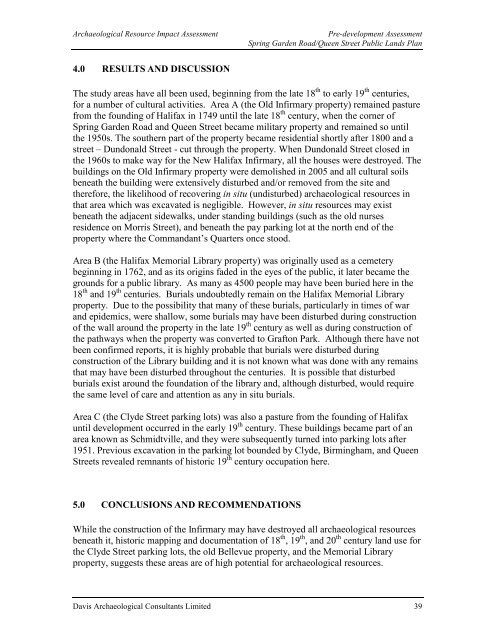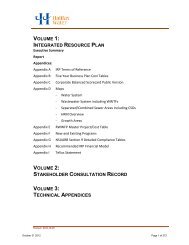Phase I - Halifax Regional Municipality
Phase I - Halifax Regional Municipality
Phase I - Halifax Regional Municipality
You also want an ePaper? Increase the reach of your titles
YUMPU automatically turns print PDFs into web optimized ePapers that Google loves.
Archaeological Resource Impact Assessment<br />
Pre-development Assessment<br />
Spring Garden Road/Queen Street Public Lands Plan<br />
4.0 RESULTS AND DISCUSSION<br />
The study areas have all been used, beginning from the late 18 th to early 19 th centuries,<br />
for a number of cultural activities. Area A (the Old Infirmary property) remained pasture<br />
from the founding of <strong>Halifax</strong> in 1749 until the late 18 th century, when the corner of<br />
Spring Garden Road and Queen Street became military property and remained so until<br />
the 1950s. The southern part of the property became residential shortly after 1800 and a<br />
street – Dundonald Street - cut through the property. When Dundonald Street closed in<br />
the 1960s to make way for the New <strong>Halifax</strong> Infirmary, all the houses were destroyed. The<br />
buildings on the Old Infirmary property were demolished in 2005 and all cultural soils<br />
beneath the building were extensively disturbed and/or removed from the site and<br />
therefore, the likelihood of recovering in situ (undisturbed) archaeological resources in<br />
that area which was excavated is negligible. However, in situ resources may exist<br />
beneath the adjacent sidewalks, under standing buildings (such as the old nurses<br />
residence on Morris Street), and beneath the pay parking lot at the north end of the<br />
property where the Commandant’s Quarters once stood.<br />
Area B (the <strong>Halifax</strong> Memorial Library property) was originally used as a cemetery<br />
beginning in 1762, and as its origins faded in the eyes of the public, it later became the<br />
grounds for a public library. As many as 4500 people may have been buried here in the<br />
18 th and 19 th centuries. Burials undoubtedly remain on the <strong>Halifax</strong> Memorial Library<br />
property. Due to the possibility that many of these burials, particularly in times of war<br />
and epidemics, were shallow, some burials may have been disturbed during construction<br />
of the wall around the property in the late 19 th century as well as during construction of<br />
the pathways when the property was converted to Grafton Park. Although there have not<br />
been confirmed reports, it is highly probable that burials were disturbed during<br />
construction of the Library building and it is not known what was done with any remains<br />
that may have been disturbed throughout the centuries. It is possible that disturbed<br />
burials exist around the foundation of the library and, although disturbed, would require<br />
the same level of care and attention as any in situ burials.<br />
Area C (the Clyde Street parking lots) was also a pasture from the founding of <strong>Halifax</strong><br />
until development occurred in the early 19 th century. These buildings became part of an<br />
area known as Schmidtville, and they were subsequently turned into parking lots after<br />
1951. Previous excavation in the parking lot bounded by Clyde, Birmingham, and Queen<br />
Streets revealed remnants of historic 19 th century occupation here.<br />
5.0 CONCLUSIONS AND RECOMMENDATIONS<br />
While the construction of the Infirmary may have destroyed all archaeological resources<br />
beneath it, historic mapping and documentation of 18 th , 19 th , and 20 th century land use for<br />
the Clyde Street parking lots, the old Bellevue property, and the Memorial Library<br />
property, suggests these areas are of high potential for archaeological resources.<br />
Davis Archaeological Consultants Limited 39
















